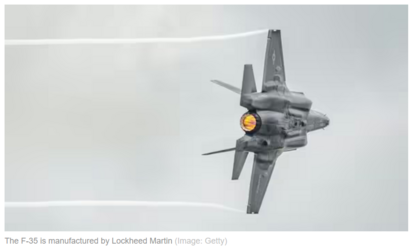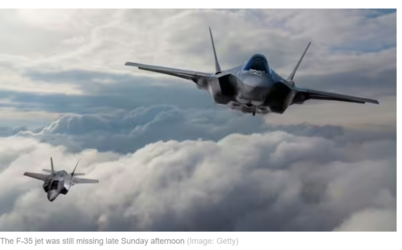Missing F-35 fighter jet disappears over South Carolina after pilot ejects in 'mishap'
The United States Marine Corps has launched a full investigation after an F-35 fighter jet has gone missing after a plot ejected over South Carolina.
The pilot was in a Marine Corps Air Station Beaufort F-35 when the incident occurred on Sunday, according to a spokesperson for the Marine Corps.
The pilot ejected over North Charleston, South Carolina at around 2pm. He was taken to a local hospital where he was in stable condition, said Major Melanie Salinas. The pilot’s name has not been released.
Based on the missing plane’s location and trajectory, the search for the F-35 Lightning II jet was focused on Lake Moultrie and Lake Marion, said Senior Master Sgt. Heather Stanton at Joint Base Charleston. Both lakes are north of North Charleston.
A South Carolina Law Enforcement Division helicopter joined the search for the F-35 after some bad weather cleared in the area, Stanton said. Military officials appealed in online posts Sunday for any help from the public in locating the aircraft.

F-35 planeThe F-35 is manufactured by Lockheed Martin (Image: Getty)
Given that the pilot was engaging in a "military exercise" at the time of the disappearance of the F-35 fighter jet, speculation continues to abound about what, exactly, the pilots were doing in the area. Officials are still investigating why the pilot ejected, authorities said.
The pilot of a second F-35 returned safely to Joint Base Charleston, Salinas said. The planes and pilots were with the Marine Fighter Attack Training Squadron 501 based in Beaufort, not far from South Carolina’s Atlantic coast.
Officials have asked for the public's assistance in finding the downed jet, something which local Congresswoman Nacy Mace blasted on social media.
Joint Base Charleston said in a tweet: "We’re working with MCASBeaufortSC to locate an F-35 that was involved in a mishap this afternoon. The pilot ejected safely. If you have any information that may help our recovery teams locate the F-35, please call the Base Defense Operations Center at 843-963-3600."
Nancy Mace responded: "How in the hell do you lose an F-35? How is there not a tracking device and we’re asking the public to what, find a jet and turn it in?"

F-35 JetThe F-35 jet was still missing late Sunday afternoon (Image: Getty)
We use your sign-up to provide content in ways you've consented to and to improve our understanding of you. This may include adverts from us and 3rd parties based on our understanding. You can unsubscribe at any time. More info
Daily Express US has reached out to a representative for the United States Marine Corps for comment.
Officially known as the Lockheed Martin F-35 Lightning II, the missing fighter jet is part of a family of stealth multirole combat aircraft.
Considered one of the elite fighter jets, these stealth bombers are an essential tool of war for the American military.
Joint Base Charleston is a huge 20,000-acre base and shares space - including runways - with Charleston International.
Around 10,000 active service members live on the enormous base.
Follow our social media accounts here on facebook.com/ExpressUSNews and @expressusnews
(+)
Source : https://www.express.co.uk/news/us/1813898/breaking-marine-pilot-ejects-f35-charleston
The United States Marine Corps has launched a full investigation after an F-35 fighter jet has gone missing after a plot ejected over South Carolina.
The pilot was in a Marine Corps Air Station Beaufort F-35 when the incident occurred on Sunday, according to a spokesperson for the Marine Corps.
The pilot ejected over North Charleston, South Carolina at around 2pm. He was taken to a local hospital where he was in stable condition, said Major Melanie Salinas. The pilot’s name has not been released.
Based on the missing plane’s location and trajectory, the search for the F-35 Lightning II jet was focused on Lake Moultrie and Lake Marion, said Senior Master Sgt. Heather Stanton at Joint Base Charleston. Both lakes are north of North Charleston.
A South Carolina Law Enforcement Division helicopter joined the search for the F-35 after some bad weather cleared in the area, Stanton said. Military officials appealed in online posts Sunday for any help from the public in locating the aircraft.

F-35 planeThe F-35 is manufactured by Lockheed Martin (Image: Getty)
Given that the pilot was engaging in a "military exercise" at the time of the disappearance of the F-35 fighter jet, speculation continues to abound about what, exactly, the pilots were doing in the area. Officials are still investigating why the pilot ejected, authorities said.
The pilot of a second F-35 returned safely to Joint Base Charleston, Salinas said. The planes and pilots were with the Marine Fighter Attack Training Squadron 501 based in Beaufort, not far from South Carolina’s Atlantic coast.
Officials have asked for the public's assistance in finding the downed jet, something which local Congresswoman Nacy Mace blasted on social media.
Joint Base Charleston said in a tweet: "We’re working with MCASBeaufortSC to locate an F-35 that was involved in a mishap this afternoon. The pilot ejected safely. If you have any information that may help our recovery teams locate the F-35, please call the Base Defense Operations Center at 843-963-3600."
Nancy Mace responded: "How in the hell do you lose an F-35? How is there not a tracking device and we’re asking the public to what, find a jet and turn it in?"

F-35 JetThe F-35 jet was still missing late Sunday afternoon (Image: Getty)
We use your sign-up to provide content in ways you've consented to and to improve our understanding of you. This may include adverts from us and 3rd parties based on our understanding. You can unsubscribe at any time. More info
Daily Express US has reached out to a representative for the United States Marine Corps for comment.
Officially known as the Lockheed Martin F-35 Lightning II, the missing fighter jet is part of a family of stealth multirole combat aircraft.
Considered one of the elite fighter jets, these stealth bombers are an essential tool of war for the American military.
Joint Base Charleston is a huge 20,000-acre base and shares space - including runways - with Charleston International.
Around 10,000 active service members live on the enormous base.
Follow our social media accounts here on facebook.com/ExpressUSNews and @expressusnews
(+)
Source : https://www.express.co.uk/news/us/1813898/breaking-marine-pilot-ejects-f35-charleston






